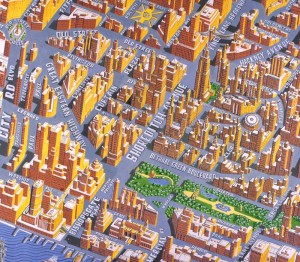 |
| Image 1. The book cover of ‘Designing Cities: Basics, Principles, Projects’ |
What is the basic knowledge for urban design? Which techniques are necessary for designing decent urban spaces? ‘Designing Cities: Basics, Principles, Projects’, written by German architect Leonhard Schenk, is navigating the answer of these questions.
The book is structured along three parts,
1) General principles of urban design
2) Practical techniques for designing cities with relative examples
3) Three sensible examples that are recently constructed and well evaluated – Hamburg (Germany), Tubingen (Germany) and Belval (Luxemburg)
When people want to make an overview from the basic theory to the completed projects, it seems a well organised book to look through all parts.
The author argues that the most urban design projects have been realised by competitions, and two factors should be incorporated to win the competitions. On the one hand, projects need to satisfy the demands of the client and the jury. On the other hand, the functionality, the design and the representation capacity of projects have to be promoted by themselves. This argument clearly indicates the direction of the book. Over 350 pages, the author illustrates in detail the systematic methods for creating urban spatial organisations and visually attractive designs.
What an interesting point of this book is the explaining principles of urban design step by step, particularly in the Chapter 1 and 2. For example, ‘the law of similarity’ describes that ‘elements that resemble one another in the form are more readily experienced as belonging together than elements are. In addition, similar elements result in more uniform groups than dissimilar ones’. (P.21, See image 3) The principles demonstrate not the characters of each element but the natures of the group as a corporate body of the elements. These rules are underestimated because too simple and too obvious. But, we could easily deep in troubles during the design process if we do not keep them in mind. And then, from the Chapter3, the author starts to explain the practical ways of urban design such as designing urban blocks, various grid structures, organising building lots, road systems, designing public space and representation skills.
 |
| Image 2. The sample page of Chpter 2. Page 18 and 19 |
 |
| Image 3. The sample page of Chpter 2. Page 20 and 21 |
A variety of example images are helpful to understand the intention of the author. The project images of international offices like OMA, BIG and KCAP, and other competition images were considerably selected, and are provided in the right positions depends on the topics. When the possibilities of diagrams are expressed to show complex relationships, for instance, the KCAP’s first prize winning diagrams for FredericiaC competition are suggested as a suitable case.(See image 8) This brings good chances not only for analysing some parts of each project but also for watching highly correlated site plans with the parts.
 |
| Image 4. Good project images are helpful to understand the intention of the author. Page 40 and 41 |
 |
| Image 5. Sample pages. Page 74 and 75 |
 |
| Image 6. Sample pages. Page 110 and 111 |
 |
| Image 7. Sample pages. Page 276 and 277 |
 |
| Image 8. Sample pages. Page 280 and 281 |
The final chapter is a weak side of the book. Much writing about the ways of urban design is focusing on the designing physical urban spaces through the pages. However, planning issues, such as the process of urban regeneration and the consortium structure, are primarily discussed rather than design issues in the last chapter which analyse successful cases of Hamburg, Tubingen and Belval. If the book places more emphasis on the design issues like the spatial characteristics of each city, it would be more adequate with the original intent of the book. Also, most project images are from the European context while some Asian projects are included. In other regions where have different geographical and societal backgrounds, more careful approaches would be demanded to apply the ways of the book.
Overall, ‘Designing Cities: Basics, Principles, Projects’ provides a good level of overview for urban design. Definitely, it is a nice reference for people who are interested in urban design and its methods. This book was honoured the best architectural books among 242 participants from DAM Architectural Book Award that was held by Deutsches Architektur museum and the Frankfurt Book Fair.
Here is the basic information of the book, and you can find more information from the links.
Designing Cities: Basics, Principles, ProjectsHardcover: 356 pages
Publisher: Birkhauser Verlag AG (25 July 2013)
Language: English
ISBN-10: 3034613253
ISBN-13: 978-3034613255
Product Dimensions: 24.4 x 17.5 x 3 cm
Amazon UK http://bit.ly/KRenmV
Continue reading »






 This time last year I published the first version of the
This time last year I published the first version of the 










